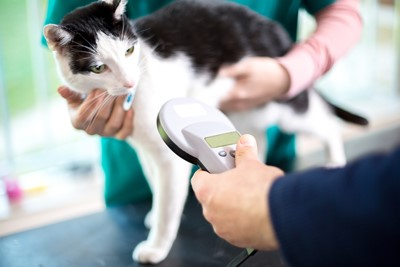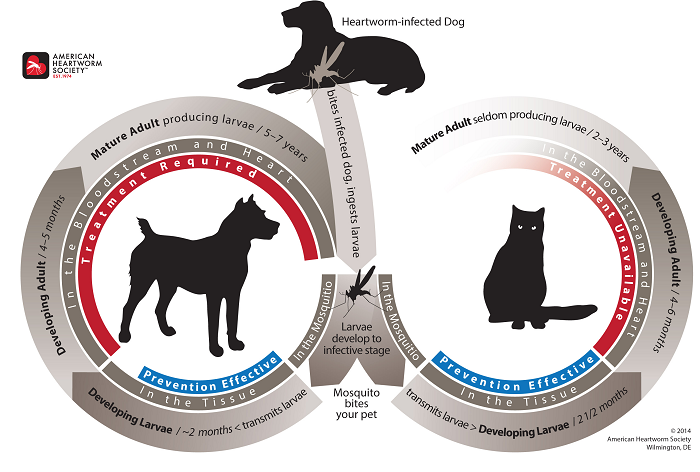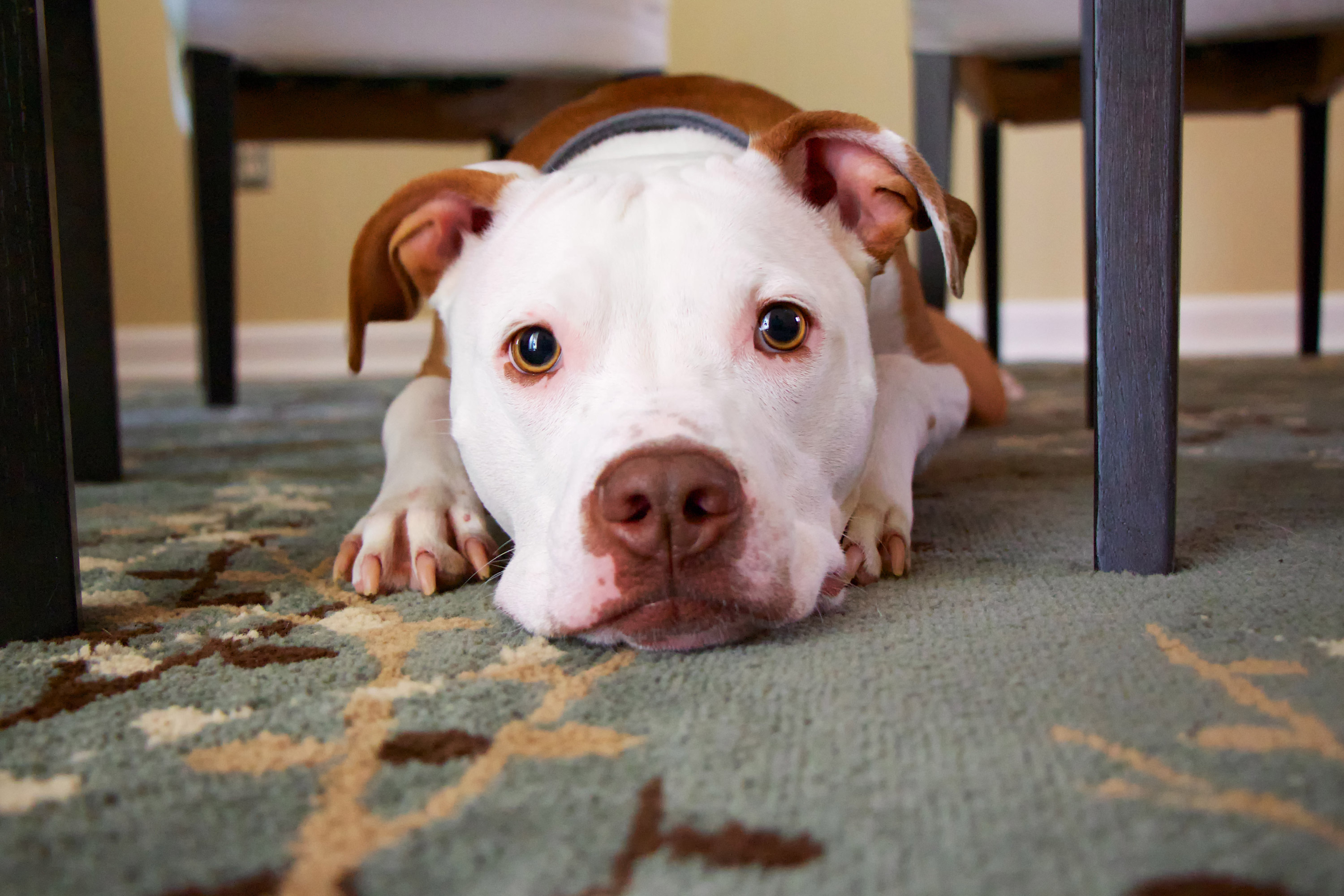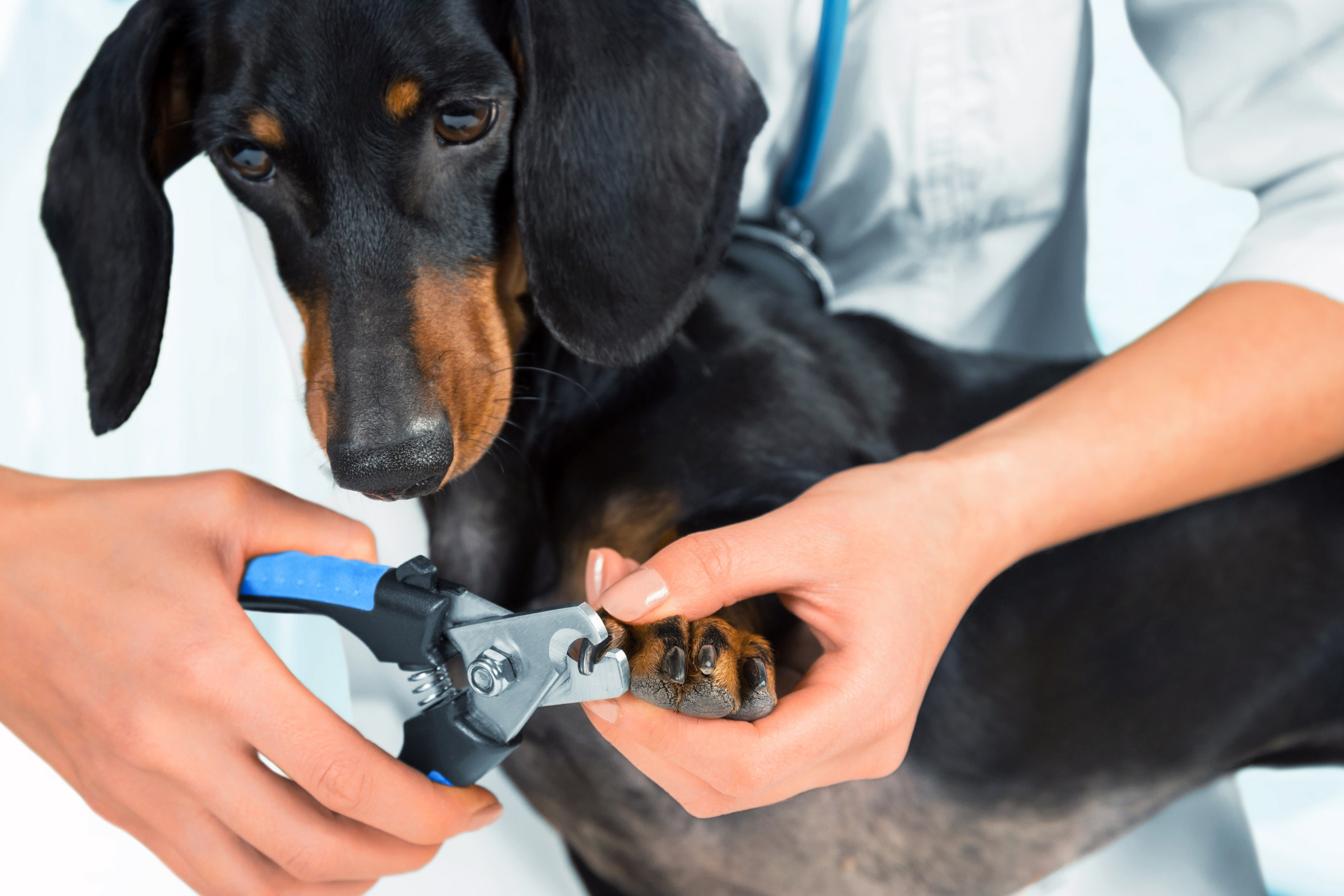Newsletter
The veterinarians and staff at the Fredericktown Animal Hospital are pleased to provide you with an  online newsletter. This fun and fact-filled newsletter is updated on a regular basis.
online newsletter. This fun and fact-filled newsletter is updated on a regular basis.
Included in the newsletter are articles pertaining to pet care, information on our animal hospital, as well as news on the latest trends and discoveries in veterinary medicine.
Please enjoy the newsletter!
May is National Chip Your Pet Month: Is Your Pet Protected?
May 10, 2022
Each year, millions of dogs and cats are lost. In fact, this disaster strikes nearly one-third of all pet-owning families. Of the millions of cats and dogs that are lost, only 10 percent are ever identified and returned to their owners. More pets’ lives are lost because owners did not identify them than from all infectious diseases combined.
All pets should wear traditional collars with identification and rabies vaccination tags. A traditional collar, however, is not enough. These collars are often worn loosely and are easily removed. Cat collars are designed to break off if the animal is caught in a tree branch. When the traditional collar is lost, removed or breaks off, nothing is left to identify the pet unless the pet has a microchip.
Microchips are rapidly becoming a very popular method for identifying pets. Once the microchip is inserted, the pet is identified for life. Microchips are safe, unalterable and permanent identification for pets. The microchip is a tiny computer chip or transponder about the size of a grain of rice. The chip is inserted under the skin between the shoulder blades of a cat or dog, in much the same way that a vaccine is administered. The microchip is coded with a unique 10-digit code. Each microchip that is inserted contains a unique code, specific to the individual pet.

Inserting the microchip is simple and causes minimal or no discomfort. The microchip comes pre-loaded in a syringe, ready for insertion. The entire procedure takes less than 10 seconds. Post-injection reactions are very rare and the encapsulated microchip remains in place permanently.
The scanner is a hand-held device used to detect the message encoded in the microchip. The scanner is passed over the animal, paying particular attention to the area between the shoulder blades. If a microchip is present, the 10-digit number (encoded in the capsule) is read by the scanner. Scanners are provided to animal control, humane shelters and other rescue organizations so that all stray pets are scanned and those with microchips are reunited with their owners. Veterinarians can also purchase scanners for use in their hospital.
The veterinary hospital where the microchip is implanted records the pet’s information and its unique microchip identification number. When a lost pet is found and scanned, the veterinary hospital is immediately contacted. Since most veterinary hospitals are not open 24 hours a day, it may take some time before you are notified. In addition to this standard registration, you can register your pet in your own name for a charge of $15-20. By doing this, as soon as your pet is found, you are notified.
Along with the additional registration fee, we recommend that you update your personal information with the microchip database on a regular basis. It is also advisable to have your veterinarian test the microchip on an annual basis in order to make sure that it is properly transmitting data.
April is Heartworm Awareness Month
April 25, 2022
Pets and their people love being outside in the summertime - and so do mosquitoes. Because mosquitoes are the most common carriers of heartworm disease, keeping pets up to date on preventive heartworm treatments during mosquito season is especially important.
Heartworms are exactly that—large worms that live in the hearts of cats and dogs. Known as Dirofilaria Immitis, heartworms are long, spaghetti-like worms that range in size from 6 to 10 inches. Heartworms are almost always transmitted by mosquitoes. A mosquito bites an infected dog or cat; that mosquito picks up microfilariae, a microscopic version of the heartworm. When that mosquito bites your dog or cat, the heartworm microfilariae are transmitted to him / her. Within 70 to 90 days, the microfilariae make it to your pet's heart and, once mature, begin reproducing. The cycle then begins again.
Signs of heartworm disease in pets vary based on the age and species of the pet and the number of worms present. Because the worms are usually located on the right side of the heart and lung, coughing and shortness of breath are common signs in both dogs and cats. Dogs that have just acquired the disease may have no signs, while dogs with a moderate occurrence of the disease may cough and show an inability to exercise. In extreme cases, dogs may experience fainting, weight loss, fever, abdominal swelling and death. In cats, the symptoms of heartworm disease are similar to those of feline asthma, including coughing and shortness of breath. Some cats may exhibit no signs of the disease, while others may suddenly die.

When it comes to preventing heartworm disease, pet owners have a number of options. Before beginning preventive medication, pet owners should have their pets tested for the presence of heartworms. If heartworms are present, a treatment plan should be discussed with your veterinarian. Most heartworm prevention is done by administering your pet a once-a-month heartworm preventive medication. Many of these monthly products are administered as a chew-able treat. Some are combined with other preventive medications. Your veterinarian will recommend the product that is best suited for your pet.
If you would like to have your pet tested for heartworm or you would like additional information about the disease, please contact your veterinary hospital.
Garden Safety Tips for Pets
March 18, 2022
Spring is upon us, and that means spending more time outdoors! If you'll be tending to a garden thing spring season, make sure you are sticking to pet-friendly plants! There are so many different types of plants and garden items that could quickly become dangerous to your pet if ingested, so talk to us if you have any questions about your plants. We've created this guide to help you create a safe outdoor space for your furry friend to enjoy.
Research Plants Before Gardening
There are so many different types of plants that can quickly become dangerous to pets, so make sure you are researching before adding something to your garden. The most common poisonous plants include:
- lilies
- sago palm
- tulips
- oleander
- philodendrons
- azaleas
- autumn crocus
- marijuana plants
- yew
- cyclamen
- chrysanthemum
- english ivy
These are just some of the most common poisonous plants for pets, but there are many others. The best way to determine if a plant is safe for pets is to research the individual plant type before adding it to your garden. Many vegetables are also poisonous to pets, such as onions, garlic, leek, and chives. Tomato plants and unripe tomatoes can also induce vomiting if ingested due to a substance called tomatine. This substance fades as tomatoes ripen, which is why it is safe for pets to eat fully developed tomatoes. Other safe garden veggies include carrots, beans, peas, celery, and zucchini.
Keep Pets Out of Your Garden
Another way you can make sure that your pet does not ingest any potentially harmful plant is to take measures to keep them out of your garden entirely. That could mean adding fencing, potting plants out of reach of animals, or perhaps keeping plants in a greenhouse. Raising your garden beds or using hanging baskets can also keep your pet and plants safe.
Choose the Right Mulch
Some mulch can be poisonous to pets, like cocoa bean mulch. This mulch has a sweet scent that could actually attract a curious nose, but it can be deadly if ingested by your pet. Avoid using this type of mulch, and instead go for something like pine, cedar, or hemlock mulch which is not poisonous. However, still make an effort to keep your pet out of these areas because some mulch can cause internal injuries, like the pine needles in pine mulch.
Fertilizers, Pesticides & Herbicides
Pesticides, herbicides, and fertilizers all help our gardens thrive, but they are absolutely dangerous for your pet to ingest. If you see a pesticide warning on neighboring lawns, try not to walk your pet in those areas. Make sure you wipe their paws after coming inside from a walk to make sure you remove any traces of pesticides that they may have picked up. It is possible for your pet to lick the chemicals off their paws and get sick, but a quick cleaning can avoid this problem. When putting down fertilizer, keep your pet indoors or far away from the area. Even organic fertilizer and compost is hazardous to pets, so just try to keep your pet away from any fertilizer whenever possible. Things like decaying plants, bones, fish meal, and blood can all smell interesting to your pet, but they can cause a variety of major health emergencies if ingested. Toxins that exist in these spaces can cause poisoning and even death if consumed by your pet, so keep them far away.
This spring, make sure you are gardening with your pet's safety in mind! Call our office if you have any further questions about garden safety tips for your pets.
Household Items that are Dangerous for Pets
February 10, 2022
Everyday household items can quickly become dangerous for pets, so make sure you are taking proper precautions to keep harmful chemicals and potentially dangerous items out of reach. Poisoning can happen in an instant, so talk to our veterinarian about your pet's unique risks.
The clearest signs that your pet has been poisoned are excessive drooling, vomiting, diarrhea, excessive thirst, lethargy, weakness, and pale or yellow-ish gums. Depending on what they ate, a reaction could be immediate or it may take several hours.
If you witness your pet ingest something that you believe may be harmful to them, you can have them drink a small amount of hydrogen peroxide to induce vomiting. This is safe for pets in small quantities, and will help them spit up whatever they have in their stomach. Use a 3% hydrogen peroxide solution. The suggested dosage is 1 teaspoon per 5 pounds of your pet's body weight, but not more than 3 tablespoons. Any more than that or using a more highly concentrated solution could be damaging.
Household items that are toxic to pets include:
- antifreeze, mulch, fertilizer, insecticides, pesticides, pool chemicals, rat bait
- cleaning supplies, bleach
- alcohol, drugs, tobacco products, certain medications
- citrus oil extracts, grapes and raisins, coffee, onions, garlic, nuts, chocolate
- xylitol (sugar-free sweetener), salt, yeast products (raw bread dough)
There are several types of plants that can be poisonous to both cats and dogs, so keep this in mind when choosing what to incorporate into your garden. Minimize the amounts of plants in your home, or make sure plants are potted and out of reach. Any plant that is on the ground could be a choking hazard for pets, and it can be tricky to make sure you are only buying pet-friendly plants. Plants can vary widely when it comes to the risk they pose to animals, so make sure you are looking up anything you are thinking of adding to your garden or home.
The best way to handle a health emergency is to prepare for one. Have our number on speed dial in case you need to call on a moment's notice. You can also create an action safety plan designed around your pet's unique risks so that you are always prepared for the worst case scenario. Putting together a pet first-aid kit can save your pet's life in an emergency, so make sure you have one in your home and your car in case something happens while you are out with your furry friend. Fast action can truly save your pet's life, so over-preparing is not a bad idea!
Take proper precautions to keep harmful substances out of your pet's reach. Keep things like medications, alcohol, and cleaning chemicals in cabinets or closets where your pet can not access them. If you have any further questions about poison prevention for pets, call our office for further information.
Quiet! Solutions for Barking Dogs
January 20, 2022
The first five reasons for barking are rarely the cause of excessive or annoying barking. They are usually specific to certain situations and are short-lived. The sixth and seventh reasons are those most likely to be considered problem barking, and they are not unrelated. Barking for companionship can turn into barking for reward: The dog barks to get its owner’s attention, the owner comes to the dog to tell it to be quiet, perhaps petting it or playing with it, before going away again. The dog is quiet while the owner is there, but has learned that barking will bring the owner back. Thus the system of barking and reward is established.
A solution, again, is to spend more time with your dog and have it near you rather than tied up somewhere separate from you. However, if your dog is separated from you and it begins to bark to get your attention, do not immediately go to the dog. It must learn that barking will not guarantee your presence. By spending more time with the dog at regular intervals not instigated by barking, your dog will feel more assured that it will get sufficient attention from you and will not have as much inclination to bark for companionship.

Teach Your Dog To Stop Barking By Understanding Prevention Steps
How do you teach a barking dog to distinguish between friends and strangers?
The solution is to show the dog that certain individuals like garbage collectors or the mailman are, indeed, friends. To accomplish this, the dog has to be introduced to these people and given an opportunity to get to know them. While this is not always practical, it is nonetheless a potential solution. As you restrain your dog, stop delivery people and have a short conversation with them, letting them meet the dog for a brief period. Repeat and lengthen the process over the next few weeks. Eventually, your dog should accept these individuals and all should be well until your regular mailman is sick and another person takes his place.
What do you do with a dog that barks at guests in your house?
One solution is to take the dog to another room and give it something to do. Or, if the guest comes to your home often and you don’t want to have to lock up the dog every time, work to gradually introduce one to the other. Have the guest get on his knees, pet the dog, offer it a treat, and more or less become part of the family. Let your dog establish the speed at which this relationship develops: Don’t force it or your dog may become alarmed by a pushy guest.
How do you deal with a dog that barks at the phone?
This is simply a case of a dog that has been rewarded for barking at a ringing phone. When the dog barks, someone eventually answers the phone and it stops ringing. To stop your dog from doing this, have a friend call and let the phone ring until the dog loses interest. Continue over a period of days, and in time, the dog will learn that barking at the phone accomplishes nothing.
Finally, what do you do with the dog that barks while you are away from home?
There are several possible solutions. One is to act as if you are leaving, then stand outside the door until the dog barks. When it does, return and scold verbally. Another is to get your dog a companion—but you might end up with two barkers! A third is to use a sound-activated tape recorder. When the dog barks, the sound switch turns on the tape recorder for a minute. The tape plays your voice scolding the dog. Some systems can repeat as many as 45 times while you are away.
The best way to reduce your dog’s barking is to pay attention to the reasons for the barking. If you can satisfy the dog’s needs, barking will automatically be reduced. By the same token, learned barking can be extremely persistent. Internal rewards can cause the cycle to go on for years.
The best solution to barking is prevention, so be aware of the possibilities and work to stop problem barking before it starts.
Advice for Locating a Lost Pet
October 23, 2018
You’ve just gotten home from running some errands and your pet is gone. Now, what are you supposed to do? Follow our simple tips and hopefully, you’ll find your loved animal soon.

Don't Wait
It’s important to start your search immediately. Make lots of noise – yell for your animal. Stop everyone you see and ask right away if they’ve seen your pet. Most of the time your pet is nearby, so they might hear you and come running back.
Consider a Reward
Consider creating a flyer with all of your pet’s information on it. Distribute them to libraries, vets, police departments and neighbors. If you are offering a reward, leave out something about your pet’s traits that they will need to identify. Also, avoid scams by staying clear of anyone asking you to wire them money.
Search Often
Go through your neighborhood multiple times each day. Talk to everyone you see along the way. You’ll also want to contact the shelters each day. Look in hiding places in the neighborhood.
Make Sure You Use Collar Tags
You can’t do this once your pet is lost, but it’s a good precautionary measure. Put your cell phone number on the tag.
Microchips
These are just the size of a grain of rice and placed under the pet’s skin. It transmits your phone number through radio frequency waves. Your vet can implant the chip speedily. Then, when your pet is found, a veterinarian and shelter can scan and attempt to contact you.
There is a small issue with microchips. They run on three varying frequencies and there are two communication protocols sold. Sometimes, a chip is missed, so you don’t want to rely on this as your only way to find your animal.
Whatever you do, don’t panic. The majority of pets are found within 48 hours. Be diligent and don’t give up searching until you find your furry friend.
Pet Statistics and Growing Trends
September 19, 2018
The pet business continues to boom with an overall focus of health across the board. Here are the hottest things happening right now and what we can expect in the future.
Natural Pet Products
Natural pet products continue to grow in popularity. That’s because most pet owners understand the high levels of toxicity in synthetic products plus there’s more of a concern for the environment.
The biggest natural pet products right now are:
• Holistic foods
• Cat litter
• Holistic grooming products
• All-natural flea and tick products
• Natural fiber toys
Specialty Pet Services
Pet services continue to grow with the increase in popularity. These aren’t always conveniences, but some things that are needed for the pet to maintain a happy life. The most common right now are:
• Dog training
• Pet sitting
• Holistic and upscale spa services like massage and Reiki
• Pet photography
• Pet behavioral consulting
• Self-serve dog washes
• Yoga
• Pet communicators
Other Popular Trends
As pet owners continue to increase their spending, luxuries seem to be topping many of the lists for trending products and services. Some other popular trends occurring now include:
Mobile pet grooming – special vehicles arrive at your home to perform grooming services.
Pet-friendly travel – hospitality and vacation locations are catering to pet owners and their furry friends.
Travel apps – apps that help to connect consumers with places to take their dogs and cats.
Pet health insurance – while they’ve been around for some time, popularity is getting larger recently.
What to Look for in the Future
As we move forward, you are going to see some more trends emerging. Pet parents are expected to see continued increases in the industry and spend more money shortly. Online shopping sites, like Amazon, have been selling record amounts of pet products and those numbers will continue to increase. Look for more innovative services, concepts, and products to emerge over the next year.
Deadly Toxins: How To Keep Your Pet Safe
August 24, 2018
The ASPCA Animal Poison Control Center has compiled a list of toxins commonly ingested by pets and for the first time ever, over-the-counter-medications proves the most problematic. Help keep your pet happy and healthy be keeping these dangerous items away from your pet.

Common potential pet toxins include:
Over-the-counter medications for humans - Acetaminophen, ibuprofen and herbal supplements were some of the most frequently ingested by pets
Prescription medications for humans - Heart medications, antidepressants, and painkillers were the most frequently ingested
Insecticides - Pet owners are encouraged to read the label of insecticides used in the yard and the home before possibly exposing pets to them
Food for humans - Garlic, onions, grapes, alcohol, and xylitol are just a few of the many human foods that can be poisonous for dogs and other pets.
Household products - These include cleaning supplies, paint and fire logs
Veterinary medications - Pet owners should be cautious with veterinary medication, especially any chewable medication which is appealing to pets.
Chocolate - Chocolate, especially dark and baking chocolate, is extremely dangerous to pets if ingested.
Plants - Keeping some greenery inside helps with maintaining fresh air within your house, but they can also be toxic to pet, especially cats. Before adding plants to your household, check to see if they could be toxic to your pet.
Rodenticides - Using rodent poisons to rid your house of mice or rats is a common enough practice but those poisons also pose a potential hazard to your pets. Make sure to keep them out of reach so your pet doesn't accidentally ingest those poisons.
Lawn and Garden Products - While maintaining your yard, be aware of herbicides and fungicides and your pets. They can be dangerous and potentially lethal if ingested.
If your pet ingests something it shouldn’t, contact your veterinarian or the Animal Poison Control Center at (888) 426-4435 immediately.
Celebrity Pets: Chances Are They’re Wealthier Than You
July 12, 2018
Feel like Grumpy Cat is everywhere these days? It’s not just you.
The famously dour feline has had a big few years since her owner posted her on Reddit in 2012. With multiple books, licensed product lines, pet food endorsement deals and even a starring role in a made-for-TV-movie, Grumpy Cat has transformed from the star of a popular YouTube video to a full-fledged brand. From TV to the big stage, Grumpy Cat even had a Broadway debut in Cats in October 2016 for a one night only appearance.
Grumpy Cat’s owner won’t say how much the cat has made, but one tabloid pegged the figure at $100 million (a figure the owner denies). And yet, it’s still not enough to make Grumpy Cat smile.

Grumpy Cat isn’t the only living meme raking in the dough. Boo, the Pomeranian dog, has signed off on licensing deals with companies like Crocs, published three books and secured a spokesdog gig with Virgin America Airlines. Of course, fame has a dark side: like many celebrities before him, he was the subject of a death hoax. Not to worry – Boo is alive and well.
Other rich pets include Chris P. Bacon, a pig who was born without the use of his hind legs who has learned to get around on wheel legs built out of toys by his owner; Lil’ Bub, a cat whose underdeveloped jaw gives him a permanent slack-jawed expression; and Tuna, a Chihuahua with an overbite that gives the pup a permanent expression somewhere between a grin and grimace. All three have millions of social media followers, book deals, product lines and endorsement deals that keep them raking in cash hand over paw.
Think your pet has what it takes to be the next A-list meme? Only one way to find out – break out the camera and get something cute on YouTube or post on Reddit. The good news for you is that it doesn’t look like the Internet’s love of animals is going away any time soon.
Clipping Your Pet's Nails
May 15, 2018
Pet owners vary in their level of comfort in clipping the nails of their dog, cat, rabbit or bird. But it is necessary to regularly clip nails to help maintain health and comfort. Nails which are uncared for can break or tear, and can affect the animal's ability to move about comfortably or cause the animal to injure itself when scratching. If you are uncomfortable clipping the animal's nails yourself, your vet or groomer can do this for you.

If you decide to do it yourself, here are a few tips:
• Remember, the nail is living tissue. Do not clip too close to the quick. If this occurs, the animal will experience pain and the nail will bleed.
• There are two types of nail clippers available: the scissor type (which resembles a traditional scissors) or the guillotine type (which surrounds the whole nail). Both are effective. Choose the one that is most comfortable for you and your pet.
• Many animals resist nail clipping. One way to get them accustomed to it is to handle their paws or feet from a very early age.
• Maintain your pet's nail clippers so that they're sharp. A dull blade and crush and fracture the nail, which is painful for your pet.
